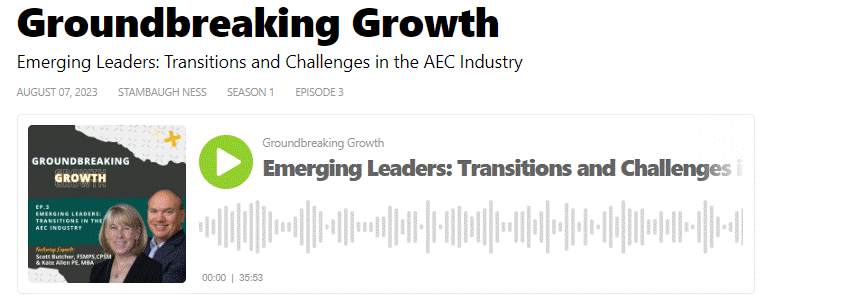Building a Better Seller-Doer

Business development and marketing within the architecture, engineering, construction (AEC), and environmental spaces are evolving due to technological advancements, generational shifts, and changing buying preferences; however, the seller-doer model continues to enjoy prominence.
Why is this?
Owners and end users have preferred to engage with individuals who will deliver their projects from the earliest introductory conversations. They want to know the personalities and understand the subject matter expertise of the individuals with whom they will work. People do business with people, so owners want to understand and vet the people leading their projects.
Owners have been burned in the past. They have been sold a bill of goods about how great an AEC firm is and how much relevant experience it has, only to get people assigned to their projects who weren’t even involved in those projects and didn’t possess the anticipated knowledge base. Firms hold contracts; people deliver projects.
But “selling” is not a natural aptitude for many AEC professionals. They didn’t become engineers, architects, or construction managers to get into sales. Not only do they lack the talent, but they also don’t have the training. Furthermore, they are busy delivering projects to existing clients. One reluctant seller-doer used to complain to me: “Would you rather have me doing the projects that we’ve already landed and keep those clients happy, or chasing work that I don’t even know where it’s coming from and neglecting my clients?”
Balancing billable work while generating new opportunities is a challenge of the seller-doer model. But the challenge is too often used as an excuse.
Emerging Leaders
Companies are constantly evolving, and with that comes generational change. Firms should be anticipatory and proactively turn emerging leaders into seller-doers as senior leadership moves toward and into retirement. When a company has relied on the same rainmakers or seller-doers for years, and those individuals are planning their exit – or have gone already – business development falls into disarray. Emerging leaders have been focused on doing the work and maybe managing it on project teams, but bringing in work has not been a priority.
Until it suddenly is.
Many AEC firms are still quite busy, but business development is about the future and keeping a steady stream of opportunities and projects in the pipeline. How can you do this when your primary seller-doers are no longer with the firm?
Building a Better Seller-Doer
The answer lies in the next generation of seller-doers. To succeed, a firm must move beyond merely having a need and create a team of results-oriented seller-doers.
Here’s advice to give your next-generation seller-doers:
Better manage your time.
Studies show that as much as half of a person’s day is spent doing low or no-value tasks. Audit your time and understand time wasters. Delegate when possible. Delay lower-value tasks. Reevaluate all those meetings that take up your week – do they need to happen? Can they be short huddles instead of hour-long meetings? Put time on your calendar for business development—better leverage technology to improve your time management and consider automation tools for more basic tasks. Free up low-value time to focus on generating opportunities.
Get training.
Ask to join your firm’s established seller-doers or business developers in their meetings. Study their techniques. Improve your soft skills. Read books and blogs about business development. Attend webinars and listen to podcasts. Request that your company send you to training or bring the training in-house. Never stop learning. Regularly discuss lessons learned with the other seller-doers in your firm and share ideas, successes, and failures – you’ll all get better.
Determine the approaches that work best for you.
Don’t put yourself in a box of believing that selling and cold calling are the same thing. Understand the myriad approaches that seller-doers use to generate work. Take DISC and StrengthsFinders 2.0 assessments, and better understand your behavioral styles and strengths, then leverage them in how you approach business development. Match your personality and comfort zone with your business development approaches.
Maximize your business development time.
Stop believing you need to know everything about a prospect or opportunity before you make a move – you’ll never get there. Utilize thought leadership to build your personal brand, demonstrate your subject matter expertise, and generate inbound leads so your business development time is primarily spent pursuing prospects and opportunities that have already expressed an interest in you and your company. Don’t confuse your time spent writing scopes of work and developing fees with actual business development.
Conduct research.
Learn what keeps your clients awake at night. Understand the market sectors or project types you operate and the trends impacting them. Research the other companies and institutions in your market space that may need your services. Learn about your clients’ clients. Read the publications that your clients read. Research the competition to understand how to better differentiate against them.
Mine your existing clients.
For most AEC firms, 80% or more of the work comes from existing clients. Look for opportunities to solve their challenges. Cross-sell when appropriate – new services, new locations, new project managers. Elevate the client experience as a trusted advisor so they not only keep coming back but expand the relationship and refer you to other organizations needing your services.
Get out there.
Join the organizations that your clients belong to. Attend the conferences and trade shows that they attend. Become active in your community to raise your visibility. Don’t only live behind a computer screen. Work your network. Take your valued clients and contacts to lunch, coffee, or a baseball game. Be consistently visible in your target markets.
The way you build a better seller-doer is through intention.
And this intentionality needs to come from the company, firm leadership, and every seller-doer. Too often, the charge of “Go get work” is merely a hollow call to action. Sure, a small percentage of seller-doers – with built-in sales aptitudes – can take that simple instruction and make it work. But for the majority of seller-doers, personalized strategy and guidance are required. Equip them with the necessary skills and tools to succeed.
What should that strategy look like? Join Stambaugh Ness in our upcoming webinar, The Path to Seller-Doer. And if you are interested in jump-starting your seller-doer strategy right now, check out Seller-Doer Training & Services by Stambaugh Ness and contact me at [email protected] to discuss your specific needs.




